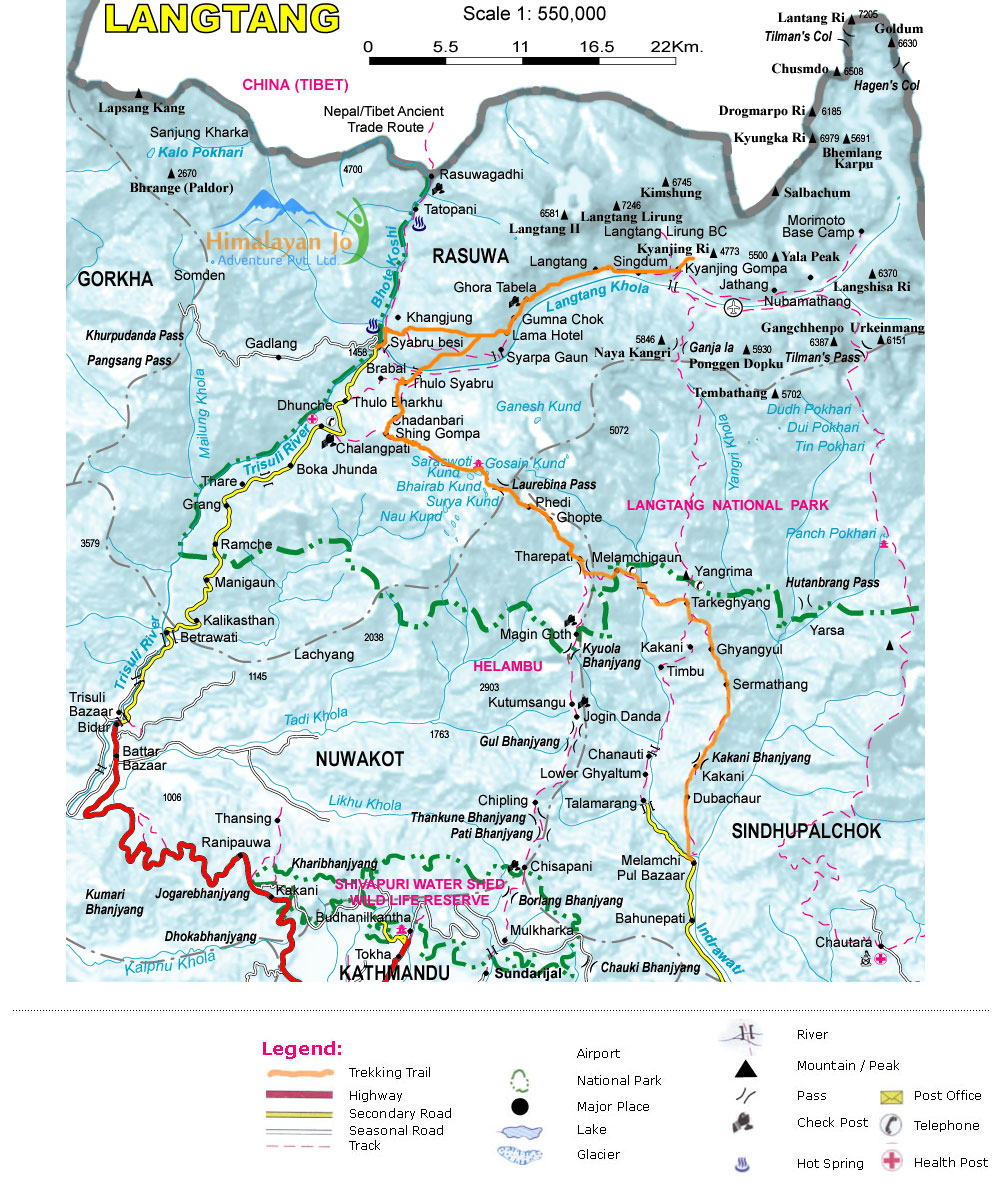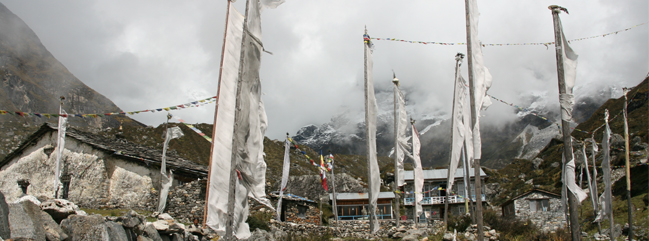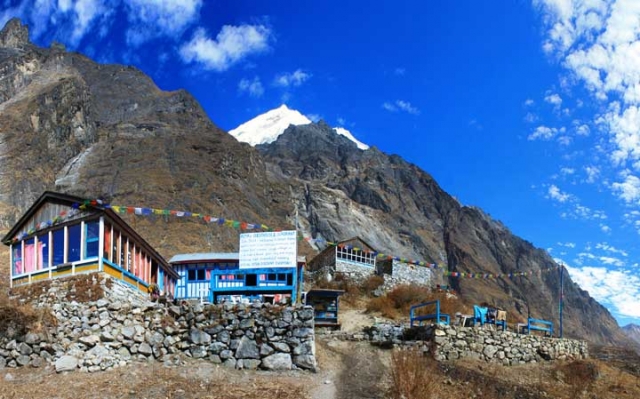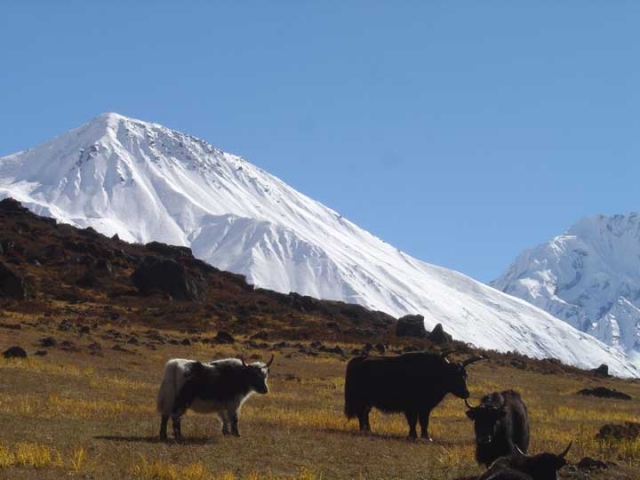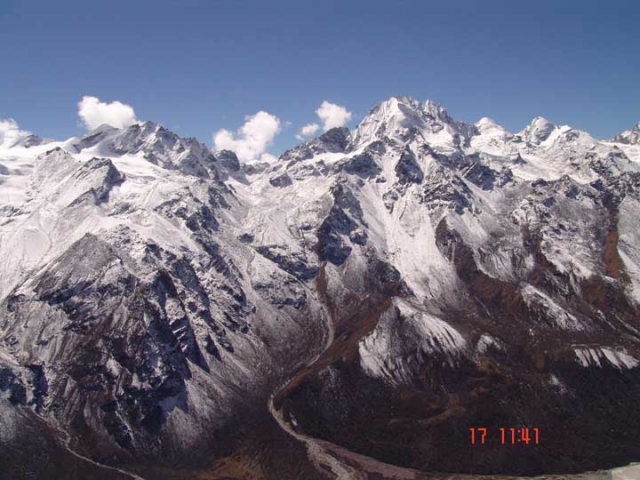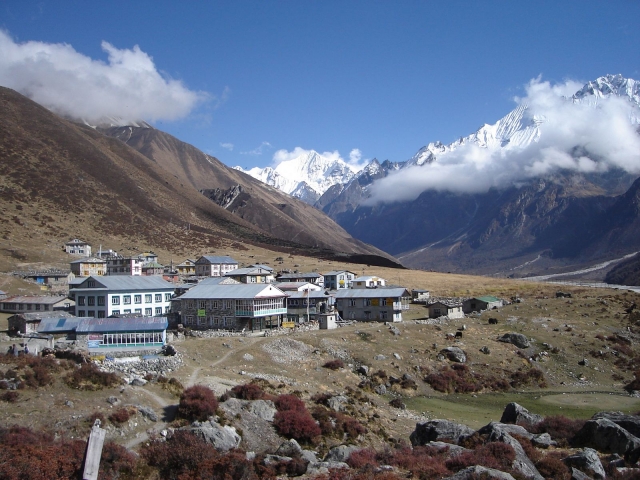If you are interested for easy, less crowded and to see the natural as well as cultural beauty of Nepal in a short time frame Helambu Village Trek can be the best option for you. Helambu Village Trek gives the traveler a general knowledge of life and culture of the Sherpa community of the lowlands. Helambu Village Trek through low elevation takes one on a journey to explore monasteries, villages, views of the central Himalayas, amid varied landscapes of Helambu. The smiling faces of local people make Helambu Village Trek one of the most interesting and unforgettable treks in your life. Helambu Village Trek runs close to Kathmandu valley so sometimes it is called Kathmandu Valley Trek.
Helambu Village Trek, View from helambu valleyThe Sherpa villages of Helambu due north of Kathmandu valley presents an easy getaway. This area because of its low elevation and the Sherpa villages make it an interesting 6 day loop. Starting with a short drive from Kathmandu to Sundarijal the trail to Helambu climbs on to the Shivapuri ridge from where there are sweeping views of the central Himalayas. Following a ridge-line the trek heads north to Thare Pati before turning east to Melemchi Gaon and Tarke Gyang the principle villages of this area. From here we visit Shermathang before descending to the Melamchi river to end our trek with a drive Melamchi Bazaar back to Kathmandu. Moderate trek through the Helambu villages between altitudes of 1,370m/4,500ft to 3,490m/11,500ft. Accommodation in comfortable lodges run by local families. The trek starts with a drive from Kathmandu and includes all meals, services of experienced trek guide and porters to carry luggage. Clients carry a light day-pack only and walk at their own pace.
Day 01 Arrival in Kathmandu.
Arrival in Kathmandu airport, reception and transfer to the hotel. Free day. Overnight stay in Kathmandu.
Day 02 Kathmandu to Chisapani (2140m)
Drive from Kathmandu to the Sundarijal northern edge of the Kathmandu valley for about 1 hour by private transport and start to hike up to Mulkharka, the sprawling Tamang village. The trail continues on a gentle climb through the forests ridges before it drops down to Chisopani. Situated on the ridge from where you can see countless snow peaks. Overnight stay in tea house at Chisapani.
Day 03 Trek to Kutumsang.
The sunrise on the Himalaya, from Annapurna to Everest, is particularly outstanding from Chisapani. After breakfast, start to walk down through agricultural fields and meadows towards Pati Bhanjyang. This is a Brahmin and Chhetri village at the bottom of the ridge at 1860m. From here the trail starts climbing up again towards Chipling where we stop for lunch. After lunch we continue to hike up through stone staircase towards the top of the Jogi danda ridge. From the ridge, through forest, the trail descends towards Tamang village of Gul Bhanjyang and then to Kutumsang. Overnight stay in tea house at Kutumsang.
Day 04 Trek to Tharepati. (3640m)
After breakfast we start to hike up to the highest point of the trek 3490m. As the vegetation becomes sparser, you’ll soon be rewarded with beautiful views across the surrounding mountain ranges and the sweeping valleys below. At the top of Tharepati, you can catch your breath and enjoy of the view of the snow-capped peaks all around you. Overnight stay in tea house at Tharepati.
Day 05 Trek to Melamchi Gaon.(2530m)
From the northern end of the village the trail turns east and drops steeply into a ravine. Here the vegetation changes to large firs, then oaks and rhododendrons, as we rapidly loose altitude. After crossing the Chhyadi Khola on a suspension bridge, the trail makes a short final ascent to the prosperous Sherpa village of Malamchigaon at 2530m. We will arrive here for lunch. After lunch you can stroll around the village.
Melamchi Gaon is a large prosperous Sherpa village with extensive fields of barley, corn and potatoes. The gompa (Tibetan Buddhist temple) here has a line of prayer flags at the front, brightly painted walls and statues of Guru Rimpoche and his consorts. Locally, it is believed that the great tantric master Guru Rimpoche mediated in a cave above the village. Overnight stay in tea house at Melamchi Gaon.
Day 06 Trek to Tarke Gyang. (2590m)
From Melamchi Gaon, the trail descends through jungle to a bamboo teashop at 2360 meter, then drops steeply through agricultural fields to the Malemchi Khola river. After crossing the suspension bridge at 1890m the trail begins its long climb towards Tarke Gyang, which is the largest village in the Helambu region. The Buddhist monastery of this village has a large brass prayer wheel. Overnight stay in tea house at Tarke Gyang.
Day 07 Trek to Sermathang (2610m)
Today is the most relaxing day of the trek. The trail remains fairly level throughout the journey, and on the way you can see local farmers working in their fertile land. After passing a couple of streams and waterfalls, you’ll end up in the village of Sermathang at 2620m. There is an unusual monastery at the highest point of the village, which has allegedly been home to a very strict elusive Buddhist order for the past few decades. The members of the order are very rarely seen, but in the evening you’ll hear their meditative prayers echoing through the valley. Overnight stay in tea house of Sermathang.
Day 08 Sermathang to Melamchi Pul Bazaar
From Sermathang the trail follows the ridge all the way down to Malemchi Pul Bazaar, making a drop of 1730 meter. Passing through the settlements of Nigale, Gyalsha and Raithani Gyang, we reach last Sherpa village of the trail Kakani. From Kakani, the trail drops steeply to the attractive village of Dubhachaur in a saddle at 1610 meter. Continuing further down the ridge our trail will eventually bring us to a large suspension bridge which crosses the Indrawati river and brings us into Malemchi Pul Bazaar. From here we will take private transportation back to Kathmandu. Overnight stay in hotel at Kathmandu.
Day 09 Melamchi to Kathmandu
Drive to Kathmandu and free day.
Day 10 Final Departure
The trip ends, our Airport Representative will drop you to the Kathmandu International Airport for your flight departure from Nepal.
NOTE: The above information is a guide and standard template of what we provide. The trek can be customized at your request to accommodate your specific requirements.
Note : On adventure trips of this type, weather, local politics, transport or a multitude of other factors beyond our control can result in a change of itinerary. It is, however, very unlikely that the itinerary would be substantially altered; if alterations are necessary the leader will decide what is the best alternative, taking into consideration the best interests of the whole group. Where a change does occur, we do everything we can to minimize its effect, but we cannot be responsible for the results of changes or delays.
Q.What type of shape do I need to be in, is this trip for me?
A. Trekking is suitable for average people who are moderately fit, thus no previous experience is required. Some physical fitness programs such as running, swimming, hiking is recommended before you embark on your journey. Persons suffering from a pre-existing medical condition or disease must seek medical advice before considering the trek. Whilst on the trek, it is common to experience some discomfort before being fully acclimatized.
To prepare for a strenuous trek you should begin training at least two to three months before your departure. As a guideline, an hour of aerobic exercise three to four times per week would be considered a minimum requirement. The best preparation is bushwalking involving relatively steep ascents and descents. If you can manage a couple of valley floor to ridgeline ascents per comfortable and able to enjoy the trek to the fullest. They are physically strong, sharp-witted and have an incredibly positive attitude towards a life that we would consider extremely tough. There is something about a trek in the Himalaya that draws you back time and time again. For keen walkers it is a paradise and even avowed non-walkers find that one foot just seems to follow the other, drawn by the appeal of what lies beyond.
Q. Will somebody come to pick me up at the Airport upon my arrival?
A. Yes, our Airport Representative will be there to greet you outside of Terminal Hall, he/she will be displaying an Kiwi Adventures Treks & Expedition sign board. Upon arrival, you will be transferred to your hotel.
Q. What sort of accommodation can I expect in Kathmandu and in trekking?
A. 11 night’s Trekking Guesthouse, 4 nights three/four star hotels in Kathmandu.
We use standard rooms from three/four star hotels in Kathmandu with breakfast included. Along the trekking routes teahouses/Lodges generally provide basic clean facilities with a mattress and a quilt or blanket. We can also offer you sleeping bags if needed (which need to return after the trip) but it is a good idea to always have your own sleeping equipment. We usually provide single and double rooms as well as the occasional dormitory. The dining room is downstairs around a fire. All food will be cooked to order in the little kitchen. You should not enter the kitchen unless asked to do so.
Q. What sort of food can I expect in trekking?
A. In trekking most teahouses (lodges) cook a delicious range of mostly vegetarian fare. Pasta, tuna bakes, noodles, potatoes, eggs, dhal bhat, bread, soups, fresh vegetables (variety depends on the season) and even some desserts like apple pies, pancakes, and some interesting attempts at custard. You will find a lot of garlic on the menu because it assists with acclimatization – eat some every day. In many larger villages you may find some meat on the menu. You can always get hot chocolate, tea, and hot lemon drinks, as well as soft drinks, and treats like chocolate and crisps.
Each day dinner and breakfast are used to take in the same lodge you spend the night. Lunch will be taken on the way to destination.
Q. What sort of transportation you use?
A. Kiwi Adventures Treks & Expedition is all about providing you with local insights as well as adventure, with that in mind, where we think you will get more out of your holiday by using different means of transport that is what we do. Using a variety of private transport is an integral part of our Himalaya tours and enhances the experience!
We use private tourist vehicles for sightseeing, city tours and pickups. Depending on the group size we use cars, minibus, van or land cruiser. These small light vehicles are more manoeuvrable and flexible enabling us to take you through the Narrow roads of Nepal. All the vehicles are usually air-conditioned unless we are travelling in cooler areas.
Q. What is the best season for this trekking?
A. Our trekking season extends from mid- September to May. From early September the monsoonal rains decrease. By end of September through to December the weather is usually stable with mild to warm days, cold nights. February, March, April, May, October, November, December are the best time to do trek.
Q. What is the weather & temperature like in trekking?
A. Weather in the mountains is notoriously difficult to predict. At night it is generally cooler the days are generally warm. Winter (January and February) will be bit colder but the days can be quite beautiful and warm if the sun is out. There will be bit of snow during the month of January, February and December. It is also important to make sure that you can stay warm and dry in just about any conditions. Expect the unexpected! The temperature could be as high as 20 deg C to -15 deg C low.
Q. Can I charge my digital camera or other batteries on my trip?
A. These facilities will be available in most of the places in your hotel reception by paying some service charges. Remember to bring your adapters!
Q. Is there any communication while we are on trekking?
A. There are telephones in some villages along the trekking routes from which you can make international calls.
Q. Can I use credit cards in the places visit in trekking?
A. In most cities yes, to some extent, however once you leave those cities behind, all you need is cash.
Q. How much additional money do I need per day?
A. In Kathmandu, you can allocate US$ 10 – 25 for a lunch / dinner. It’s all depends on your spending habits. US$7 to 10 US$ a day will be enough to buy bottles of water, chocolates and few drinks in trekking.
Q. Do I need to tip my guide and porters? How much would that be?
A. This is a difficult thing to gauge. We have seen everything from 20USD to 1000 USD per person for guides and porters. Tipping is not required, but a small way to show your guides and local porters thanks for their help. The level of the tip should reflect the level of personal involvement with your guide.
Q. Is the water OK to drink? Do I need to bring purifying tablets/filter?
A. In most places bottled water is readily available. If you wish to drink normal water, you need to use purifying aid, which you will need to bring with you.
Q. Are the Kiwi Adventures Treks & Expedition staff insured?
A. Our company insures all our trekking staff, including guide, cook, sherpa and porters.
Q. What essential documents do I need to bring with me on tour?
A. *Valid Passport – must be valid for up to 6 months after you return from your tour, keep a separate photocopy.
*Travel insurance, keep a separate photocopy
*Cash and Traveller’s Cheques, keep numbers and proof of purchase separate
*Flight tickets
*Emergency contact numbers for T/C’s, banks, insurance, family contacts.
Q. Can I add extra days to my trekking trip?
A. A hoilday should never be about making it to the final point quickly. Along your trek we can add days at your request with additional costs to cover guides, porters, accommodation and food.
Q. Do you use yaks/porters on the trek or do we carry all of our own gear?
A. Whilst on the trek, our porter will take care of your luggage. All you need to carry is your small day bag for your personal belongings like camera, water bottle, sun cream etc only.
Q. What opportunities will I have for shower along the trek?
A. In major places, we arrange guesthouse with hot shower. And in rest of the places, hotel water in bucket will be provided for shower; it would cost you extra about USD 3-4 per shower.
Q. Do you know about how many total miles the trek is?
A. Total distance of the entire trek is about 75 miles.
Cost Includes
• Airport / Hotel / Airport pick up & drop by private car / van / bus.
• Heli Charter till Ghoda Tabela
• Standard accommodation in four/five star hotel in Kathmandu breakfast included.
• Guided city tour in Kathmandu by car / van / bus.
• Sightseeing/Monuments entrance fees in Kathmandu.
• All your standard Meals (breakfast, lunch and dinner) during the trek.
• Best available Lodges, Guesthouses accommodation during the trek (mainly in twin sharing).
• A local government licensed English speaking Guide during the trek.
• The required number of staff and Porters to carry your luggage during the trek.
• Food, accommodation, salary, insurance, equipment, medicine and transportation for all trekking/tour staff.
• Langtang National Park permits.
• First aid medical kid.
• Surface transfer from and to Kathmandu.
• All our government taxes.
• Official expanse.
Cost Excludes
• Lunch and dinner whilst in Kathmandu.
• Your travel insurance (compulsory).
• International airfare and airport departure tax.
• Nepal entry visa fee (US$ 30 per person) you obtain a visa easily upon your arrival at Tribhuwan International Airport Kathmandu for 60 days from date of issue. You will require 2 passport size photos.
• Alcoholic, hot and cold drinks, laundry.
• Personal trekking Equipments.
• Tips for trekking staff. (Tipping is expected).
• Any others expenses which are not mentioned on Price Includes section.
